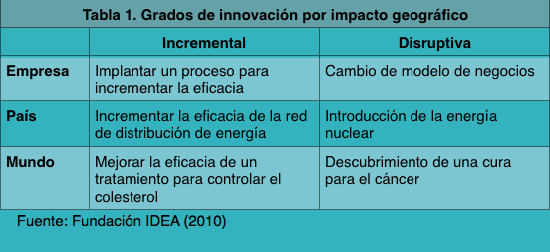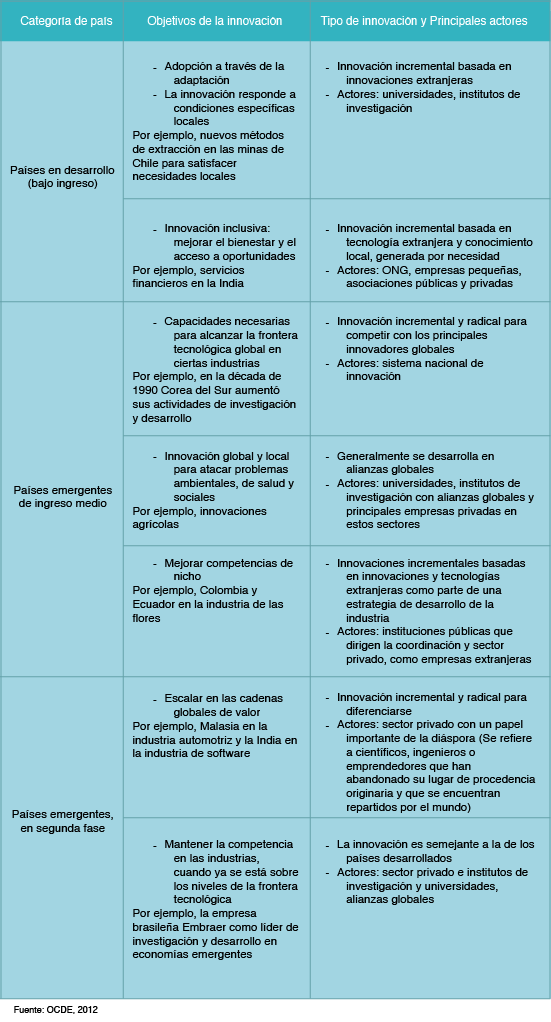“Innovation,” a term that everyone knows but few apply
Posted By Ceci On 15 July, 2014 @ 11:20 am In Entrepreneurship,Edition 49 | Comments Disabled
 By: Pamela Gallardo
By: Pamela Gallardo
In the present context of great uncertainty, market volatility, economic stagnation and international competition, it is necessary to find new ways to boost a country’s economy and development.
In the present context of great uncertainty, market volatility, economic stagnation and international competition, it is necessary to find new ways to boost a country’s economy and development (Venture Institute, 2013). Thomas L. Friedman, in his book, The World is Flat (2007), argues that the reduction in trade and political barriers, as well as the technological advancement, are leveling the way business is conducted worldwide, and as a result, the key to differentiate oneself will be through innovation.
Presently, the sources of economic growth have changed. Slowly, the traditional sources, such as capital or labor, are being replaced by other sources, such as infrastructure in information and communications technologies (ICT). We also see that the greatest problems of our society, such as transportation, education, environmental protection, medicine, agriculture and even “democracy,” require creative and efficient solutions that promote and implement advances in science and technology (Venture Institute, 2013). Without a doubt, innovation is increasingly a key factor to sustain long-term development and economic growth, improve the population’s well-being, generate employment and promote the creation of new industries (Venture Institute, 2013, 2). At the beginning of the 20th century, Joseph Schumpeter pointed out the importance of ideas and technology as factors that determine economic growth, since they generate solutions and radical changes that enable increased productivity (Romer, 1986 and Venture Institute, 2013).
Optimism about the impact of innovation on productivity and economic growth has grown in recent years. There is no doubt that innovation creates a virtuous circle, particularly in emerging countries; thus, economic growth is driven by addresing social problems through innovative solutions, and vice versa Such was the case of the Green Revolution in India in the 1970s (OECD, 2012, 10). What is more important is that beyond the theory, the development of innovation capabilities has been an important factor in the strategy of growth for the most dynamic economies, such as those of China, India and Korea (OECD, 2012, 4-7).
In this way, a fairly broad consensus has been generated regarding innovation as a key factor to bolster and sustain development and economic growth in the long term. However, we cannot say that there is the same consensus on its definition nor, therefore, on its measurement. Different national and international organizations have proposed different definitions of what innovation it is.
- “Unlike an invention, an innovation is the economic sense that accompanies the first commercial transaction with the idea of a new product, process or system, even when the word is used to describe the whole process” (Freeman, 1982).
- “Invention is the creation of a new product or process, but innovation is the introduction of change for something new.” (Rouse, 1992).
- “The ability to innovate has less to do with the ability to make discoveries of technological principles and more to do with the ability to systematically exploit the effects produced by new uses or combinations of the components” (Foray, 1998).
- “The introduction of a new good, one that consumers are not familiar with, or a new quality of a good; the introduction of a new method of production; the opening of a new market; the conquest of a new source of raw material or intermediate goods; or the creation or elimination of a monopoly” (Schumpeter, 2004)
- “The introduction of a new or significantly improved product (good or service), process, marketing method or organizational method in business practices, the organization of work or external relations” (Oslo Manual, 2005).
- “Innovation also occurs when a product or process is introduced; when competition imitates a pioneering business in an innovation; when minor improvements or adaptations are made to a product or process … That is to say, innovation also occurs through creative imitation” (UNCTAD, 2007, 6).
- “Any change or creation that generates value. It is a process that involves the incorporation of new technologies and knowledge that in the long run transform the economy and productivity of a country, region or company” (Venture Institute, 2013).
The list of definitions can continue as we further probe this concept. Similarly, not all actors in the entrepreneurial ecosystem share the same definitions of innovation. Expansion magazine devoted its special 45th-year anniversary issue to innovation in Mexico (April 2014). For that edition, the magazine conducted interviews with subject-matter experts: specialists, academics and entrepreneurs. For some, innovation consists of identifying a need and finding solutions to address it, and it does not imply per se an application of technology. For others such as Don Strickland, former executive at Apple and Kodak, to innovate is not just creativity in finding new ways of doing things, but it implies the creation of value. Others, including Jeffrey Beir, mentor at Harvard iLab, are more demanding and consider that an incremental improvement is not an innovation unless it meets a clear and specific need. For Rogelio de los Santos, cofounder of Alta Ventures capital fund, innovation differs from an invention by its market perspective. Thus, we can conclude that in general for some actors in the entrepreneurial ecosystem, an innovation is characterized by three components: 1) the creation of something new 2) which transforms the business, market or country, and, therefore, 3) creates value.
Why measure innovation?
In recent years, we have witnessed countless national and international efforts to measure and compare the performance of countries in regards to entrepreneurship, innovation, or science and technology. Evaluating and measuring innovation is important to better understand how it is expressed in each country. Based on such an evaluation, decisions can be made about business strategies and public policy. Measuring and understanding innovation is a crucial activity if one wants these strategies and policies to be truly effective. Thus, specific indicators have become increasingly necessary in order to understand innovation and its relation to the economic development of countries (Anlló, and Schaaper Marins, 2013).
In general, innovative ideas can be classified by their purpose and novelty. According to the goal of knowledge, innovation can be directed toward a product, process, market or organization (OECD, 2005):
- Product. Introduction of a good or service that is new or significantly better compared to its previous characteristics or uses.
- Process. Establishment of a production process or a delivery method that is new or significantly improved. This includes technical changes in equipment or software.
- Market. Establishment of a new marketing technique that represents a major change in the design, packaging, promotion or price of a product.
- Organizational. Establishment of a new organizational method in the company’s practices or how it works internally and externally.
Because of its novelty, an innovation can be classified as incremental or disruptive, depending on its contribution to knowledge and its geographical impact (Johannessen, Olsen and Lumpkin, 2001, OECD, 2005; Christensen, 1997). A disruptive innovation is one that creates new paradigms or markets. An incremental innovation produces gradual improvements in the same technology or field of knowledge; generally, these changes deal with the effectiveness of the product, not with its function (Fundación IDEA, 2010, 11). These classifications can be divided into categories based on geographical impact.
Any actor within society can give rise to an innovation: business, industry, public sector, academia, etc. (OECD, 2010). However, innovation often arises through the interaction of the complementary activities of such actors.
Innovation in Mexico
To summarize, innovation is now more than ever a determining factor of the levels of productivity and competitiveness and therefore of a nation’s economic growth. A country’s capacity for innovation depends on the suitable interaction between government, scientific community, businesses and industry. This gives rise to the concern about the state of innovation in Mexico. In terms of innovative capacity, Mexico is well below countries with which it competes directly. Mexico suffers from the Peter Pan syndrome, as it is described by The Economist (May 2014), given that about 90% of companies employ less than 50 people, they are oriented to local markets, their contribution to the total value of production is low, and they yield few innovative activities, which results in a lack of efficiency, productivity, technology and innovation. This explains why much of the investment in research and development is carried out by the public sector. When the private sector allocates very scarse resources to innovation, industrial infrastructure is in a low technological state, and there is a shortage of highly skilled human resources. If Mexico wants to achieve higher levels of growth and improve its competitive position in the world, it must bet on the path of innovation, which implies a proper alignment among the actors: government, scientific community, universities, businesses and industries.?
References
- Anlló, Guillermo, Luciana Marins y Martin Schaaper. (2013). Estadísticas de innovación: El desafío de la comparabilidad. El Estado de la Ciencia 2012, RICYT: 65-79
- Christensen, Clayton M. (1997). The Innovator’s Dilemma: When New Technologies Cause Great Firms to Fail. Boston, Harvard Business School Press.
- Expansión (2014). “Innovación en México”. April, no. 1138.
- Foray. Dominique (1998). “The economics of knowledge openness”, in Nathalie Lazaric and Edward Lorenz (comps.), In Trust and Economic Learning,. Edward Elgar Publishing.
- Freeman, Christopher (1982). “The Economics of Industrial Innovation”. University of Illinois at Urbana-Champaign’s Academy for Entrepreneurial Leadership Historical Research Reference in Entrepreneurship, http://ssrn.com/abstract=1496190.
- Friedman, Thomas L. (2007). The World Is Flat: A Brief History of the Twenty-First Century. D&M Publishers Incorporated.
- Fundación IDEA. (2010). ¿Quiénes son los emprendedores innovadores mexicanos?
- Johannessen, J., Olsen, B. & Lumpkin, G. (2001). ”Innovation as a newness: What is new, how new, and newto whom?” European Journal of Innovation Management. 4(1) pp. 20-31.
- OCDE (2005). Manual de Oslo, 3a. ed., París, OECD.
- OCDE (2010). The OECD Innovation Strategy: Getting a head start on tomorrow.
- OCDE (2012). Innovation for development.
- Romer, P. M. (1986). “Increasing returns and long-run growth”, The Journal of Political Economy, 1002-1037.
- Rouse William. B. (1992). Strategies for Innovation: Creating Successful Products, Systems, and Organizations. John Wiley and Sons, Inc.
- Schumpeter, Joseph (2004). The Theory of Economic Development, Cambridge University Press.
- The Economist (2014). “The Peter Pan Syndrome”, The Economist Newspaper Limited.
- UNCTAD (2007). The Least Developed Countries Report 2007: Knowledge, Technological Learning, and Innovation for Development. United Nations Conference on Trade and Development, Ginebra / Nueva York.
- Venture Institute. (2013). Índice Nacional de Innovación.
Article printed from Dirección Estratégica: http://direccionestrategica.itam.mx
URL to article: http://direccionestrategica.itam.mx/innovacion-un-termino-que-todos-conocen-pero-pocos-aplican/
URLs in this post:
[1] Image: http://direccionestrategica.itam.mx/wp-content/uploads/2014/07/tablas_1.png
[2] Image: http://direccionestrategica.itam.mx/wp-content/uploads/2014/07/tablas_2.png

